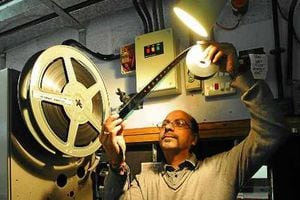Has the reel run out for cinema projectionists?
As cinemas make the switch from film to digital technology, the role of the traditional movie projectionist looks set to disappear. Mark Andrews talks to one of a dying breed.

As cinemas make the switch from film to digital technology, the role of the traditional movie projectionist looks set to disappear.
talks to one of a dying breed.
 The cinema projectionist leads a life shrouded in mystery, romance and glamour.
The cinema projectionist leads a life shrouded in mystery, romance and glamour.
Few of us notice them as they go about their business, but we all know what they look like, don't we?
Thin-lipped young men who live in a dark, dusty hideaway at the back of the cinema, illuminated only by a thin beam of flickering light, accompanied by the rapid clicking of the spools.
If you're going to modern multiplex, it is more likely to be somebody sat behind a desk in an office, surrounded by computer screens.
Old-school projectionists, like Jas Kapur of Wolverhampton's Light House cinema, are a dying breed as cinemas make the switch from using film to digital technology.
Traditionally, the job involved taking the film out of a metal can and lacing an endless stream of tiny pictures into a projector.
"With digital it is like a giant memory stick, you put it into a computer and then play the film," says Jas.
For the 49-year-old,movies have been a way of life, ever since he began making films on his brother's Super-8 cine camera as a child.
As soon as he left school, he went to work at Wolverhampton's old ABC cinema, and he remained there until the cinema closed in 1991.
"Then like a shining beacon across the way, The Light House opened, and I have been there ever since."
But not even the Light House, which has built up a reputation as a traditional arthouse cinema, has escaped the digital revolution.
"At the moment the downstairs is digital, and we're hoping to convert the upstairs as well, but we will be retaining our 35mm projector because we show a lot of archive films."
The Odeon Group, Britain's largest cinema chain with multiplexes at Brierley Hill, Telford and Birmingham, completed its conversion to digital last year.
 The rival Showcase cinema in Dudley has already made the switch, with all its other cinemas to follow suit by the end of the year.
The rival Showcase cinema in Dudley has already made the switch, with all its other cinemas to follow suit by the end of the year.
Phil Clapp of the Cinema Exhibitors' Association, says the switch will inevitably mean a major change in the role of the projectionist.
"While a 35mm projector is a mechanical device with moving parts, a digital projector – aside from the lamp – is very much a piece of IT," he says. "Projectionists who have been able to strip down and reassemble a 35mm projector with the eyes closed are suddenly being presented with a box with an on-off switch."
The main driving force behind the switchover has been the film industry itself, says Jas Kapur.
"A lot of the films you get now are only available on digital," he says.
There are many advantages of the digital revolution, particularly in terms of picture quality. While traditional films pick up scratches and other faults over the years, every digital transmission should be as good as the first.
Adam Day, of Showcase Cinemas, says it means multiple screens will be able to show 3D content, including live events such as opera, ballet and sport, through satellite link-ups.
He says all Showcase cinemas will retain the ability to screen some 35mm films where digital prints are not available, or for special events.
While that sounds like progress, the 35mm film still has a loyal following, in the same way that many people still prefer vinyl over CDs.
"I like the film, but I'm an old fashioned projectionist," says Jas Kapur.
"If the film breaks you can rectify it straight away, you can repair the film and relace it, but if it's all electronic, it's much more complicated."
But there is another reason why the giant cinema chains love digital. It is much cheaper. Not only does it require fewer projectionists, it also means there is no need for the large projection rooms that housed the old equipment, making for more efficient use of space.
Jas says the idea of multiplex cinemas using single projectionists operating several screens is not a new one. "The whole idea of the multiplex cinema was a way of streamlining operations, as you could have a large projection room in the middle serving several screens," he says. "If the cinemas want to streamline even more than that, that will be up to them."
Edward Fletcher, of film distributor Soda Pictures, says on he predicts a return of the smaller, high street cinema, showing a mixture of mainstream and independent films.
But they might not need many staff. "In place of the projectionist, you could have one person in a business park in Stevenage sat in front of a bank of screens. That person could programme their entire group of cinemas on a laptop."
Adam Day declines to comment on the number of projectionists employed at the Showcase cinemas in Dudley and Walsall.
But Jas Kapur believes there will still be a need for projectionists even at cinemas which are fully digital.
"I think most cinemas will keep some projectionists, just to check everything is working properly."
One fierce critic of the switch to digital is the movie commentator Mark Kermode, whose book The Good, The Bad, And The Multiplex bemoans the declining service of the cinema industry.
"A cinema that doesn't have a projectionist but does have a fast-food stand is not really a cinema at all, is it?," he says.
One thing beyond doubt is that a generation from now, the likes of Jas Kapur will be few and far between.
"Some war veterans were at the Light House recently, and they were saying they are the last few left, how their stories are going to be lost when they are gone," he says. "It made me think, in years to come, it will be harder for future generations to learn how we used to run cinemas the traditional way."
P.S. Hello to Jason Isaacs





